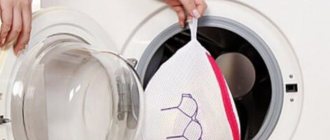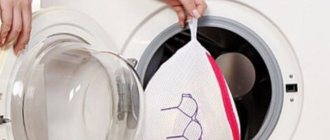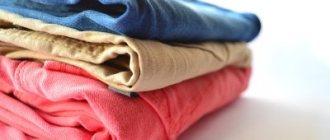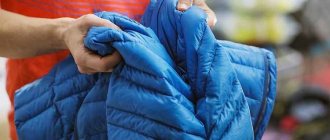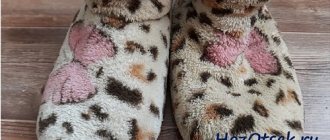A down jacket is the most popular clothing for winter. While real fur has been considered “not a trend” for several seasons, jackets and down jackets are becoming the favorites of more and more people. I also love down jackets. My family members and I each have several models in our closet. Most of all, I respect down jackets. Those filled with down and feathers. Because on cold days they really keep you warm, but on warm days they are not hot. Since we wear down jackets regularly, we wash them often too. In this article, I collected tips from the World Wide Web and my own observations on the topic of washing down jackets. I hope you find it useful.
Explanation of icons on the label
Each manufacturer sets its own washing rules. The following icons can be found on down jackets, indicating what can and cannot be done with the product:
- Horizontal line inside . Indicates flat drying.
- Three vertical lines. Dry in a hanging position without squeezing.
- A circle inside a square with a dot. Drum drying should be done at low temperatures.
- The same icon with two dots inside. The tumble drying temperature remains normal.
- Crossed out icon. Prohibition of machine drying.
If the down jacket has an emblem in the basin and the symbol 40, then machine washing is acceptable. The picture of an iron crossed out with several lines adds a ban on ironing.
Professional down jacket care is indicated by the symbols F and P inside a small circle. A crossed out circle indicates a ban on professional dry cleaning.
Additional elements include one or more stripes, indicating the most delicate wash.
Items of this type should be washed by hand with the addition of conditioners or rinse aids. In some cases, the water temperature is indicated by dots, so be careful.
Which down jackets can be machine washed, and which are dry clean only?
When purchasing a down jacket, look at the instructions for use attached in the form of icons. Carefully study the label on the model, which displays the composition of the material and fillers.
It also contains requirements for proper care of the down jacket. If you see a picture of a container with a hand placed in it, this means that washing is only permissible by hand.
If you find a basin with the specified temperature, it means machine washing is permissible.
Before cleaning, determine whether a full wash is necessary or whether a minor treatment can be done. The latter is needed if there are stains on the fabric, or if the collar or sleeves are dirty.
Timely cleaning keeps the filler in good condition, since manipulations only affect the surface.
Never neglect the rules for caring for your down jacket. If the item cannot be washed, do not do it.
Otherwise, you will deform the filler, which will lead to its uneven distribution throughout the fabric.
Additional recommendations
To make washing effective and safe, you must consider the following recommendations:
- Treat the most contaminated areas (sleeves, collar, etc.) in advance with washing gel or approved bleach, but do not soak the entire jacket.
- Before starting the SMA, remove and thoroughly rinse the powder compartment (cuvette).
- When using new wash balls, soak them in hot water or chlorine bleach to test color fastness (improperly colored wash balls may stain fabric).
- If the item is heavily soiled or has stains of unknown origin, then it is better to prefer dry cleaning to delicate washing.
Preparing a down jacket for washing
Preparing a down jacket is a step no less important than washing itself.
Incorrect actions during preparation can lead to troubles in the form of white spots on the fabric or deterioration in the quality of the filler.
This will happen regardless of the type of down (biological, Thinsulate, feather down, padding polyester options). Ultimately, the down jacket will simply stop performing its functions.
As already mentioned, read the labels carefully before washing. After this, empty the pockets and unfasten the hood (fur, if any).
Examine the down jacket. If there are grease stains on it, it is better to soak them using special products and remove them. If they are not there, you can proceed to the next step.
Check the integrity of the product. It may be damaged (holes, deformation of the snake, filler, etc.).
Damage must be repaired immediately, otherwise it will become larger after washing. Fasten all clasps, zippers, snaps and buttons.
Turn the product inside out and put it in the washing machine.
As you can see, the process of preparing a down jacket for washing is as simple as possible if you do it carefully and carefully.
Why are balls needed and what can replace them?
A good addition to all of the above are balls for washing down jackets. These are sold in hardware stores, usually in quantities of 4 pieces. They are used to ensure that the fluff does not get confused or roll off. Before washing, two balls are placed in the pockets of the down jacket, and two more are simply placed in the drum of the washing machine. Also among the offers you can find magnetic or tourmaline balls. However, these are extremely difficult to find, and their price is higher.
What can you replace the balls with if you can’t find them in stores?
- Tennis balls. Just before washing, check to see if their coating is fading. The dye is not always permanent.
- Massage balls will also be a good replacement for special balls. The main thing is to use rubber, not plastic. The latter can ruin the thing.
- Oddly enough, washed potatoes will do the job. True, there is a risk of leaving stains on dark fabric, so it is best to use young tubers.
How to wash a down jacket in a machine
At the moment, there are many different products for washing down jackets. Despite the opinion of the majority, you can use not only powder, but also other chemicals.
Shampoos for washing
Shampoo for washing down jackets is a type of gel. Now you can find shampoos for hand washing that interact well with the fabric of the product.
The disadvantage is the high price, since the shampoo is much more concentrated than regular powder.
Products for delicate fabrics
If the manufacturer recommends washing the down jacket by hand, it is better to purchase products for delicate cleaning.
They contain fewer aggressive substances. Sometimes natural ingredients are added to them, including fragrances, essential oils, herbal extracts, etc.
Washing sportswear
Many gels are intended not only for down jackets, but also for sportswear.
The fact is that the fabric structure of these categories of items is noticeably different from everyday clothing. This assumes that the effect on the tissue will be different.
Some manufacturers recommend washing your down jacket using sports products.
Bleaches
It is not advisable to wash a down jacket with bleach. The substances contained in it are extremely aggressive and have a bad effect on the fabric and filler.
It actively dissolves the fatty layer present on the down, which promotes thinning.
Capsules
In some cases, laundry capsules come in handy. The capsule is a small container filled with a gel.
Sometimes the composition includes not only a cleaning agent, but also conditioners, rinses, etc. Thus, the capsule contains everything.
If the tag indicates that the down jacket can be washed with the addition of conditioner, you can purchase capsules. They have a concentrated liquid solution that prevents white spots from occurring.
The disadvantage is the cost - the capsules are quite expensive compared to other products in the same category.
How to dry properly
When you have figured out how to properly wash a down jacket, all that remains is to understand the nuances of drying it. Let's imagine that you take out a jacket. Don’t be alarmed if you see that the down jacket has become like a thin autumn windbreaker, and the filling has bunched up in the corners. This is not the end. The drying stage will help return feathers and down to their rightful places. The main thing is to know exactly how to dry.
The diagram looks like this:
- unbutton clothes, pockets, zippers;
- turn right side out;
- hang on hangers;
- leave to drain in the bathroom if not all the moisture has been squeezed out;
- Place in a room with good ventilation or on a balcony;
- You can speed up drying using warm air generated by a hairdryer;
- knead the filler with your hands often and shake the product so that it quickly returns to its shape and the filler is evenly distributed inside the down bag.
If it was not possible to distribute, you can rinse the product again and dry it again using our instructions.
For reference! Make sure the product is completely dry. Wet filling runs the risk of molding or rotting, resulting in the jacket having to be thrown away.
For example, in long down jackets with quilting, you need to carefully knead each section with your fingers. You will feel how you distribute the feathers and fluff with your hands. However, it is worth it because once the coat dries, it will look like new.
Long down jacket-cocoon
In what program can you wash a down jacket?
Mode for bulky items
This option is ideal for volumetric models. It is included in many modern models of washing machines.
Designed for items that absorb a lot of liquid. The washing time is no less than one hour and no more than two hours.
The washing machine manufacturer LG calls this option “bulk mode.” In general, the name does not differ too much between different companies.
This mode uses a lot of water, so take this into account before washing.
Handwash
This mode allows you to wash any items gently and slowly. They undergo the least deformation, which is important in the case of a down jacket.
Hand washing is similar to the “delicates” option, but still different. Temperatures range from 30 to 40 degrees Celsius.
In this case, the washing machine consumes more water than in normal modes. This avoids excessive friction on the drum.
After washing, the down jacket will not be deformed.
Some manufacturers have included the option of setting the hand wash mode (decrease/increase the number of revolutions, decrease/increase the temperature, etc.). Choose what is needed specifically in your case.
Hand washing is provided in every modern washing machine model.
Duvet
You can also try the “duvet” mode, which is gentle on things. The option is intended for washing items containing fluff or similar elements (sintepon, etc.).
The lowest possible temperature (30 degrees Celsius) keeps clothes in their original condition. The minimum operating time is 40 minutes.
LG models have the ability to customize the mode by enabling the “no folds” or “intensive” function.
If you have a soak function, turn it on before the main wash. The process will take less time than if done manually.
Why not dry cleaning?
If you carefully look at the instructions for your down jacket, you will most likely notice that the manufacturer does not recommend machine washing at all, but recommends going to dry cleaning. However, this dry cleaning method contains a number of significant disadvantages:
Many housewives advise putting badminton balls
- High price . Sometimes the price of a down jacket seems ridiculous compared to the cost of cleaning it annually according to the manufacturer’s advice.
- Lack of responsibility. Many dry cleaners, before accepting a product from a client, require you to sign a service agreement, which, among other things, also states that the company does not bear any responsibility for the result. That is, if you end up with some semblance of your once cute down jacket, then no one will be to blame for this, and you will not be compensated for the damage.
- Time . Throwing an item into the machine, taking it out, hanging it to dry, or going to the same dry cleaner are actions that require very different time commitments.
- Harmfulness. It is not a fact that trace chemical elements of the substances used to clean your jacket will not remain in the filler. Contact with them will definitely not benefit allergy sufferers and small children.
No more than 30 degrees!
Down jacket spinning
Not all models of down jackets can be wrung out. If there are no contraindications for spinning on the indicated label, it can be performed.
Remember: the spin cycle for down jackets should be gentle. Set the machine to 400-500 rpm to reduce the likelihood of mechanical damage.
Never select the half-load option, even if the down jacket takes up less of the drum.
The more water, the better. Clothing absorbs a lot of liquid, and this should not be prevented.
Washing with plenty of water minimizes the potential risk of fabric tearing.
Preparatory measures
Simple, time-consuming steps will help improve your washing results:
Remove the fur collar and belt with metal buckle (if these parts are present in a particular model). Large metal parts can oxidize and damage the machine drum.- Remove all contents from your pockets - hardly anyone will be happy with a washed bill or flash drive, and small items that fall out can ruin the filter.
- If necessary, wash away heavy stains with laundry soap (usually on the cuffs, collar and hem).
- Fasten buttons, snaps, Velcro and zippers.
- Turn the jacket inside out to protect small parts from damage.
What to do if the filler is crumpled
If you find any bumps inside the down jacket after washing, you can move the filling yourself.
To do this, lay the product on a horizontal surface, then carefully feel the fabric. Smooth out the fluff using slow movements.
Next, you should leave the down jacket until completely dry (horizontally or vertically). Remember to shake your clothes periodically to avoid new lumps.
A rather interesting way to avoid lumps is the tennis ball method. When washing, just throw a few tennis balls into the machine and turn on the no-rinse mode.
The optimal number of balls is three.
It is advisable not to wring out a down jacket that is washed in this way. Just hang it upright.
What to do about stains from washing
If you find white streaks, do not rush to panic. These are residues of detergent that can be easily removed.
Try filling a spray bottle with clean water, spraying onto stained areas and wiping them off with a dry cloth. This method works great on surface stains.
It is advisable to take a rag from soft materials: cotton, microfiber.
If the first method does not help, you can use dishwashing detergent. Dissolve a teaspoon of the product in a glass of water, wet a cloth with this solution and gently wipe the dirty area.
There are also special cleaning wipes. Their main advantage is that they do not leave any traces behind.
However, keep in mind that only specialized products are suitable - simple wet wipes will not only not remove dirt, but will also leave new stains.
When there are too many stains, you need to rinse the clothes again. You can do this yourself, or you can run the manual mode with rinsing in the machine.
In some cases, re-washing is required if you are dealing with grease stains or old dirt. In any case, it is necessary to ensure complete cleanliness of the product.
Drying a down jacket
The first thing to do is look at the labels. Depending on the manufacturer, choose vertical or horizontal drying.
Many people recommend choosing the vertical option, but it is not suitable for cases where the coat has been washed by hand. For machine washing, preference should be given to the vertical drying method.
During drying, avoid direct sunlight and drafts. Try to keep the temperature below 25 degrees Celsius.
If the weather is frosty outside, you can shake your jacket indoors and in the cold from time to time. This way the product will gain greater freshness.
Keep clothing away from heating devices, sun and open flames.
Now you know more about the rules for caring for a down jacket. Try not to stretch the product, regularly clean it of dirt, and then the item will serve you for a long time!
Should I use conditioner?
Definitely use it, it won't hurt. By using a conditioner, you will get rid of static electricity and promote the volume of the inner layer.
Bleaching white things at home - useful tips on how to bleach gray and yellowed white things (135 photos and videos)How to wash baby clothes: how and with what to wash clothes for newborns correctly (145 photos and videos)
How to wash machine oil - how to quickly and efficiently remove oil stains (75 photos + video)
